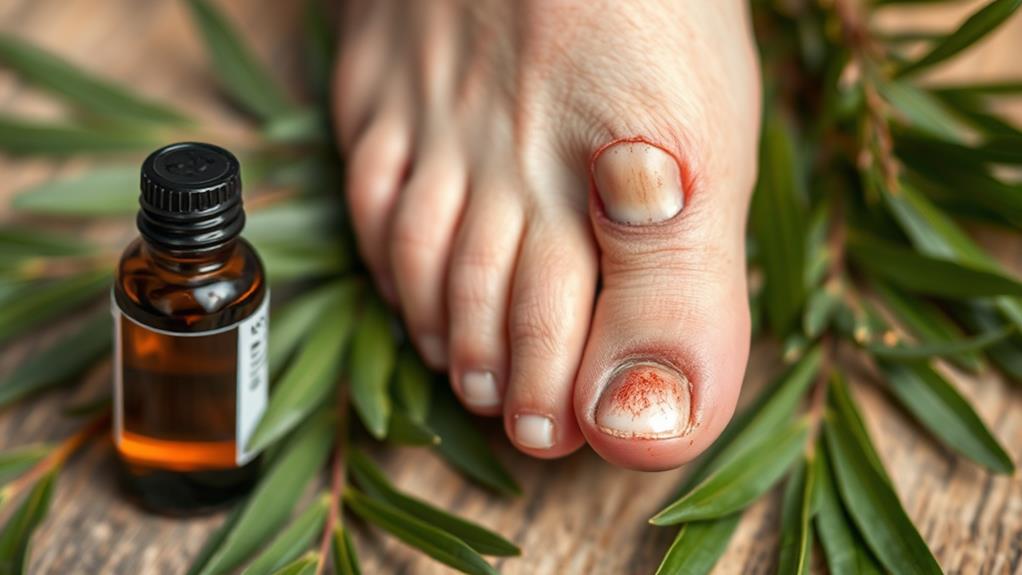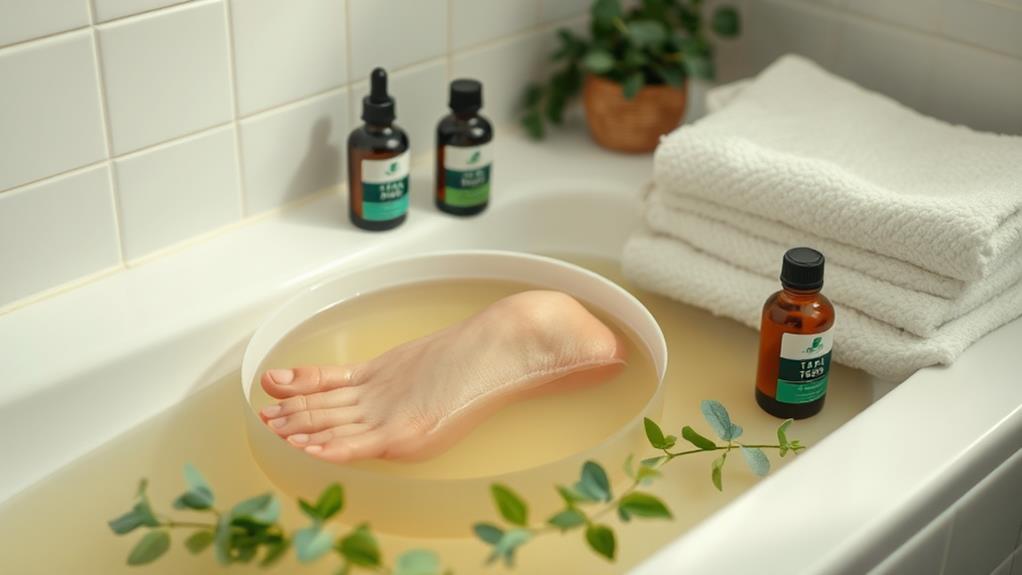If you're dealing with toenail fungus, you might find that tea tree oil offers a promising solution thanks to its natural antifungal properties. By understanding how to effectively apply this oil, you can target the infection more efficiently. You'll need to know the right techniques and the signs of toenail fungus to guarantee you're on the correct path to recovery. Are you ready to explore the best practices for using tea tree oil and discover how it can complement your overall treatment plan?
Understanding Tea Tree Oil

When you consider natural remedies for toenail fungus, tea tree oil stands out due to its powerful antifungal, antibacterial, and antiviral properties. This essential oil comes from the leaves of the Melaleuca alternifolia plant and has been widely recognized for its ability to tackle various skin conditions, including nail infections caused by fungi like Trichophyton rubrum.
Research shows that using tea tree oil can greatly reduce the growth of this pesky fungus, often leading to noticeable improvements in just 14 days.
To use tea tree oil effectively, it's important to dilute it with a carrier oil. A good rule of thumb is to mix 1-2 drops of tea tree oil with about a half to one teaspoon of carrier oil. This not only minimizes the risk of skin irritation but also helps your skin absorb the oil better.
Before you engage, don't forget to perform a patch test! This quick test checks for allergic reactions, as some people might experience redness, swelling, or itching after applying it.
Consistency is key when using tea tree oil for toenail fungus. You'll want to apply it regularly over several weeks or even months, as the visible improvement will come from new, healthy nail growth replacing the infected nail.
Effective Application Techniques
To achieve the best results with tea tree oil for toenail fungus, it's crucial to apply the oil using effective techniques. Start by diluting 1-2 drops of tea tree oil with ½ to 1 teaspoon of a carrier oil, like coconut or olive oil. This step reduces the risk of skin irritation, making it safer for you.
Next, grab a cotton swab or ball to apply the diluted tea tree oil directly to the affected nails and the surrounding skin. Make sure to cover the entire infected area for maximum effect.
For an extra boost, soak your affected nails in warm water mixed with a few drops of tea tree oil for 20-30 minutes before applying the diluted mixture. This can help soften the nail and prepare it for treatment.
Consistency is key, so maintain an application schedule by using the diluted tea tree oil twice daily—once in the morning and once before bed. Stick with this routine for several weeks or until you notice improvement.
Additionally, don't forget to regularly clean and trim your infected nails. Keeping them tidy promotes healing and helps prevent further fungal growth.
Make sure the area stays dry and well-ventilated, as moisture can encourage fungus. By using these effective application techniques, you'll be on the right path to overcoming toenail fungus and restoring your nails to health!
Recognizing Toenail Fungus Symptoms

Recognizing toenail fungus symptoms early can make a significant difference in your treatment journey. Toenail fungus, also known as onychomycosis, often starts with small white or yellow spots under the nail tip. If you notice these early symptoms, it's vital to pay attention, as they can progress to more severe discoloration.
Your nails may begin to appear white, yellow, brown, or even black, which can be alarming. As the fungal infection worsens, you might see changes in your nail's texture. Affected nails often become thickened, weak, crumbly, or jagged. They can separate from the nail bed, making them more vulnerable to cracks and further infection.
If you start to notice a foul odor, that's another sign you could be dealing with toenail fungus. Risk factors for toenail fungus include age, previous nail injuries, excessive sweating, and existing health conditions like diabetes or psoriasis. If you identify with any of these risk factors, it's important to be vigilant about monitoring your nails.
Treating toenail fungus in its early stages can lead to better outcomes, and incorporating remedies like tea tree oil may help combat the infection. Remember, the sooner you recognize these symptoms, the sooner you can start your treatment journey.
Complementary Home Remedies
While tea tree oil is a popular natural remedy for toenail fungus, several complementary home remedies can enhance your treatment efforts. Incorporating these additional methods can boost your antifungal properties and improve your overall foot hygiene.
One effective home remedy is vinegar soaks. By soaking your affected toes in a vinegar solution for about 20 minutes each day, you create an acidic environment that can inhibit fungal growth.
Another option is using garlic paste. Crushing garlic cloves and applying them to the affected area for around 30 minutes daily can harness garlic's antifungal capabilities, giving your treatment a powerful boost.
You might also want to take into account Listerine foot soaks. The combination of menthol and thymol in Listerine can help combat toenail fungus effectively, making it a great addition to your routine.
Additionally, over-the-counter antifungal creams can work wonders when paired with tea tree oil. These creams provide extra antifungal action, enhancing your chances of clearing up the infection.
Lastly, don't underestimate the importance of consistent foot hygiene. Washing your feet thoroughly and ensuring they're completely dry is vital in preventing and treating toenail fungus.
Combining tea tree oil with these complementary home remedies can provide a well-rounded approach to tackling toenail fungus effectively. So, think about integrating these methods into your treatment plan for the best results!
Recovery and Prevention Strategies

After incorporating complementary home remedies, it's important to focus on recovery and prevention strategies to guarantee lasting results. Using tea tree oil consistently is key. It can take several months to see visible improvement in toenail fungus, but as you notice new healthy nail growth, you'll feel encouraged.
Maintaining proper foot hygiene is essential in preventing recurrence after treatment. Make sure to keep your feet clean and dry, and remember to trim your nails regularly. Keeping them short not only looks neat, but it also reduces the risk of fungal infections.
When you wash your feet, dry them thoroughly, especially between the toes, to help keep them free from moisture. Using antifungal powders in your shoes can provide an additional layer of protection. These powders help absorb moisture and prevent the growth of fungi.
It's also wise to avoid walking barefoot in damp public spaces, like locker rooms or swimming pools, where fungal spores thrive. After you've seen improvement, don't stop using tea tree oil right away. Continued application can help prevent recurrence since fungal spores can linger in your environment.

